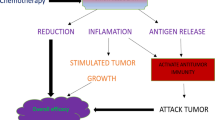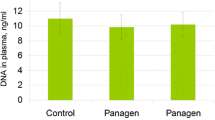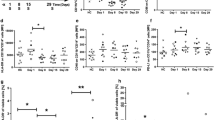Abstract
Antineoplastic chemotherapy still consists in the major first-line therapeutics against cancer. Several reports have described the immunomodulatory effects of these drugs based on in vitro treatment, but no previous data are known about these effects in patients and its association with immunological-mediated toxicity. In this study, we first characterize the immunological profile of advanced breast cancer patients treated with doxorubicin and paclitaxel protocols, immediately after chemotherapy infusion. Our findings included an immediate plasmatic reduction in IL-1, IL-10, and TNF-α levels in doxorubicin-treated patients, as well as high levels of IL-10 in paclitaxel patients. Further, it was demonstrated that both drugs led to leukocytes oxidative burst impairment. In vitro analysis was performed exposing healthy blood to both chemotherapics in the same concentration and time of exposition of patients, resulting in low IL-10 and high IL-1β in doxorubicin exposition, as low TNF-α and high IL-1 in paclitaxel treatment. Nitric oxide levels were not altered in both in vivo and in vitro treatments. In conclusion, our data revealed for the first time that the immediate effects of chemotherapy could be mediated by cytokines signaling in patients and that the results observed in patients could be a resultant of host immune cells activation.



Similar content being viewed by others

References
Fargeot P, Guerin J (1984) Role of chemotherapy in adjuvant treatment of breast cancer: modulation of the immune status. Bull Cancer 71(4):346–353
Casares N, Peguignot MO, Tesniere A, Ghiringhelli F, Roux S, Chapul N, Schmitt E, Hamai A, Hervas-Stubbs S, Obeid M, Coutant F, Métivier D, Pichard E, Aucouturier P, Pierron G, Garrido C, Zitvogel L, Kroemer G (2005) Caspase-dependent immunogenicity of doxorubicin-induced tumor cell death. J Exp Med 202(12):1691–1701
Dorsey JF, Mintz A, Tian X, Dowling ML, Plastaras JP, Dicker DT, Kao GD, El-Deiry WS (2009) Tumor necrosis factor-related aposptosis-inducing ligand (TRAIL) and paclitaxel have cooperative in vivo effects against glioblastoma multiforme cells. Mol Cancer Ther 8(12):3285–3295
Kaneno R, Shurin GV, Torukova IL, Shurin MR (2009) Chemomodulation of human dendritic cell function by antineoplastic agents in low noncytotoxic concentrations. J Transl Med 7:58
Joo HG (2003) Altered maturation of dendritic cells by taxol, an anticancer drug. J Vet Sci 4(3):229–234
Manthey CL, Perera PY, Salkowski CA, Vogel SN (1994) Taxol provides a second signal for murine macrophage tumoricidal activity. J Immunol 152(2):825–831
Brignoni C, Guitierrez M, Metfi F, Brain E, Jarcau R, Cvitkovic F, Bousetta N, Medioni J, Gligorov J, Grygar C, Marcu M, Triebel F (2010) First-line chemoimmunotherapy in metastatic breast carcinoma: combination of paclitaxel and IMP321 (LAG-3Ig) enhances immune responses and antitumor activity. J Transl Med 8:71
Mullins DW, Burguer CJ, Elgert KD (1999) Paclitaxel enhances macrophage IL-12 production in tumor-bearing hosts through nitric oxide. J Immunol 162:6811–6818
Denkert C, Darb-Esfahani S, Loibl S, Anagnostopoulos I, Johrens K (2011) Anti-cancer immune response mechanisms in neoadjuvant and targeted therapy. Semin Immunopathol 33(4):341–351
Pae HO, Jun CD, Yoo JC, Kwak HJ, Lee SJ, Kook YA, Park RK, Chung HT (1998) Enhancing and priming of macrophages for superoxide anion production by taxol. Immunopharmacol Immunotoxicol 20(1):27–37
Kim YM, Paik SG (2005) Induction of expression of inducible nitric oxide synthase by Taxol in murine macrophage cells. Biochem Biophys Res Commun 326(2):410–416
Zaks-Zilberman M, Zaks TZ, Vogel SN (2001) Induction of proinflammatory and chemokine genes by lipopolysaccharide and paclitaxel (Taxol) in murine and human breast cancer cells lines. Cytokine 15(3):156–165
Jun CD, Choi BM, Kim HM, Chung HT (1995) Involvement of protein kinase C during taxol-induced activation of murine peritoneal macrophages. J Immunol 154(12):6541–6547
Kirikae T, Ojima I, Kirikae F, Ma Z, Kuduk SD, Slater JC, Takeuchi CS, Bounaud PY, Nakano M (1996) Structural requirements of taxoids for nitric oxide and tumor necrosis factor production by murine macrophages. Biochem Biophys Res Commun 227(1):227–235
Mullins DW, Alleva DG, Burger CJ, Elgert KD (1997) Taxol, a microtubule-stabilizing antineoplastic agent, differentially regulates normal and tumor-bearing host macrophage nitric oxide production. Immunopharmacology 37(1):63–73
Fawcett H, Mader JS, Robichaud M, Giacomantonio C, Hoskin DW (2005) Contribution of reactive oxygen species and caspase-3 to apoptosis and attenuated ICAM-1 expression by paclitaxel-treated MDA-MB-435 breast carcinoma cells. Int J Oncol 27(6):1717–1726
Czuba ZP, Król W, Hasinski P, Nowowiejska A (1998) The effects of taxol (paclitaxel) on chemiluminescence of neutrophils, macrophages and J.774.2 cell line. Acta Biochim Pol 45(1):103–106
De Rossi T, Panis C, Victorino VJ, Freitas LF, Herrera ACSA, Cecchini R (2009) Breast cancer and oxidative stress in chemotherapy. Appl Cancer Res 29(4):150–156
Elsea CR, Roberts DA, Druker BJ, Wood LJ (2008) Inhibition of p38 MAPK suppresses inflammatory cytokine induction by etoposide, 5-fluouracil and doxorubicin, without affecting tumoricidal activity. PLoS ONE 3(6):e2355
Mills PJ, Ancoli-Israel S, Parker B, Natarajan L, Hong S, Jain S, Sadler GR, von Kanel R (2008) Predictors of inflammation in response to anthracycline-based chemotherapy for breast cancer. Brain Behav Immun 22(1):98–104
Byrd-Leiffer CA, Block EF, Takeda K, Akira S, Ding A (2001) The role of MyD88 and TLR4 in the LPS-mimetic activity of Taxol. Eur J Immunol 31(8):2448–2457
Palsson-Mcdermott EM, J’Oneill LAJ (2004) Signal transduction by the lipopolysaccharide receptor, Toll-like receptor 4. Immunology 113:153–162
Zielinski CC, Muller C, Kubista E, Staffen A, Eibl MM (1990) Effects of adjuvant chemotherapy on specific and non-specific immune mechanisms. Acta Med Austriaca 17(1):11–14
Kang DH, Weaver MT, Park NJ, Smith B, McArdle T, Carpenter J (2009) Significant impairment in immune recovery following cancer treatment. Nurs Res 58(2):105–114
Beitsch P, Lotzová E, Hortobagyi G, Pollock R (1994) Natural immunity in breast cancer patients during neoadjuvant chemotherapy and after surgery. Surg Oncol 3(4):211–219
Chen Y, Jungsuwadee P, Vore M, Butterfield DA, Clair DKS (2007) Collateral damage in chemotherapy: oxidative stress and nontargeted tissues. Mol Interv 7(3):147–156
Panis C, Herrera ACSA, Victorino VJ, Campos FC, Freitas LF, De Rossi T, Colado Simão NA, Cecchini AL, Cecchini R (2011) Oxidative stress and hematologycal profiles of advanced breast cancer patients subjected to paclitaxel or doxorubicin chemotherapy. Breast Cancer Res Treat. doi:10.1007/s10549-011-1693-x
Mukhergee S, Banerjee SK, Maulik M, Dinda AK, Talwar KK, Maulik SK (2003) Protection against acute adryamicin-induced cardiotoxicity by garlic: role of endogenous antioxidants and inhibition of TNF-α expression. BMC Pharmacol 3:16–25
Panis C, Mazzuco TL, Costa CZ, Victorino VJ, Tatakihara VL, Yamauchi LM, Yamada-Ogatta SF, Cecchini R, Rizzo LV, Pinge-Filho P (2011) Trypanosoma cruzi: effect of the absence of 5-lipoxygenase (5-LO)-derived leukotrienes on levels of cytokines, nitric oxide and iNOS expression in cardiac tissue in teh acute phase of infection in mice. Exp Parasitol 127(1):58–65
Kukovetz EM, Bratschitcch G, Hofer HP, Egger G, Schaur RJ (1997) Influence of age on the release of reactive oxygen species by phagocytes as measured by a whole blood chemiluminescence assay. Free Rad Biol Med 22(3):433–438
Galon J, Costes A, Sanchez-Cabo F, Kirilovzki A, Mlecnick B, Lagorce-Pages C, Tosolini M, Camus M, Berger A, Wind P, Zinzindohoue F, Bruneval P, Cugnenc PR, Trajanoski Z, Fridman WH, Pages F (2006) Type, density and location of immune cells within human colorectal tumors predict clinical outcome. Science 313:1960–1964
Leek RD, Landers R, Fox SB, Ng F, Harris AL, Lewis CE (1998) Association of tumor necrosis factor alpha and its receptors with thymidine phosphorylase expression in invasive breast carcinoma. British J Cancer 77(12):2246–2251
Reed JR, Leon RP, Hall MK, Schwertfeger KL (2009) Interleukin 1-beta and fibroblast growth factor receptor 1 cooperate to induce cyclooxygenase-2 during early mammary tumorigenesis. Breast Cancer Res 11:R21
Gewirtz DA (1999) A critical evaluation of the mechanisms of action proposed for the antitumor effects of the anthracyclin antibiotics adriamycin and daunorubicin. Biochem Pharmacol 57:727–741
Brandão HN, David J, Couto RD, Nascimento JAP (2010) Química e farmacologia de quimioterápicos antineoplásicos derivados de plantas. Quim Nova 33(6):1359–1369
Denardo DG, Coussens LM (2007) Inflammation and breast cancer. Balancing immune response: crosstalk between adaptative and innate immune cells during breast cancer progression. Breast Cancer Res 9:212
Allen JN, Moore AS, Wewewrs MD (1993) Taxol enhances but not induce interleukin 1-β and tumor necrosis factor-α production. J Lab Clin Med 122:374–381
Choi SC, Oh HM, Park JS, Han WC, Yoon KH, Kim TH, Yun KJ, Kim EC, Nah YH, Cha YN, Chung GHT, Jun CD (2003) Soluble factor from urine bladder tumor-2 cell elevates nitric oxide production in macrophages and enhances the taxol-mediated macrophage cytotoxicity on tumor cells. Cancer Invest 21(5):708–719
Santos-Silva MC, Freitas MS, Assreuy J (2006) Involvement of NF-κB and glutathione in cytotoxic effects of nitric oxide and taxol on human leukemia cells. Leukemia Res 30(2):145–152
Jia L, Schweizer J, Wang Y, Cerna C, Wong H, Revilla M (2003) Effect of nitric oxide on cytotoxicity of taxol: enhanced taxol transcellular permeability. Biochem Pharmacol 66(11):2193–2199
Halliwell B, Gutteridge JMC (2007) Free radicals in biology and medicine, 4th edn. Oxford University, New York
Halliwell B (2006) Phagocyte-derived reactive species: salvation or suicide? Trends Biochem Sci 141:312
Schmielau J, Finn OJ (2001) Activated granulocytes and granulocyte-derived hydrogen peroxide are the underlying mechanism of suppression of T-cell function in advanced cancer patients. Cancer Res 61:4756–4760
Young RC, Ozols RF, Myers CE (1981) The anthracycline antineoplastic drugs. N Engl J Med 305:139–153
Scripture CD, Figg WD, Spareboom A (2005) Paclitaxel chemotherapy: from empiricism to a mechanism-based formulation strategy. Ther Clin Risk Manag 1(2):107–114
Acknowledgments
We are grateful to Jesus Vargas for excellent technical assistance, Fundação Araucária and CAPEs for providing financial support.
Conflict of interest
The authors declare no conflict of interest.
Author information
Authors and Affiliations
Corresponding author
Rights and permissions
About this article
Cite this article
Panis, C., Lemos, L.G.T., Victorino, V.J. et al. Immunological effects of Taxol and Adryamicin in breast cancer patients. Cancer Immunol Immunother 61, 481–488 (2012). https://doi.org/10.1007/s00262-011-1117-0
Received:
Accepted:
Published:
Issue Date:
DOI: https://doi.org/10.1007/s00262-011-1117-0



